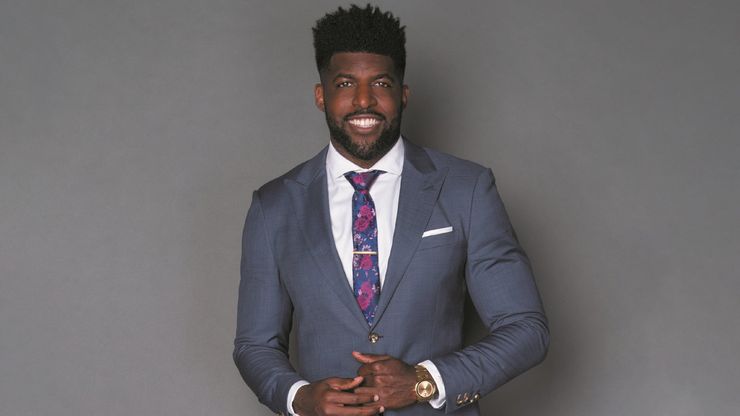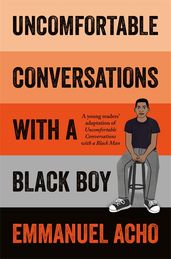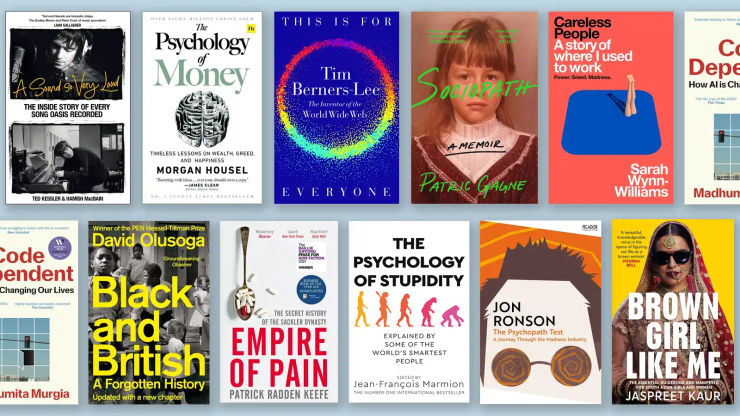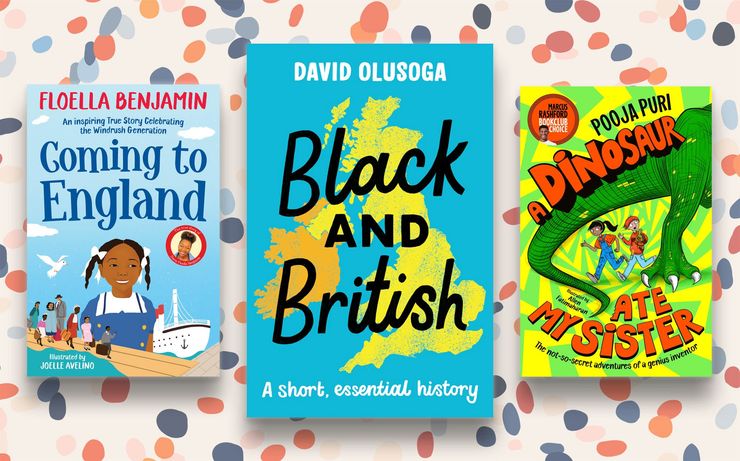Emmanuel Acho on the myth of the 'Angry Black Man'
Former NFL player and current Fox Sports analyst Emmanuel Acho explores the myth of the Angry Black Man, and the ways in which this damaging stereotype has been amplified and weaponised.

From cinematic racist tropes to contemporary police murders, Emmanuel Acho describes how the justifiable anger of black men who have experienced racism is used to justify violent actions against them. In this bias-challenging piece, the author of Uncomfortable Conversations with a Black Boy creates a space for parents and teens to talk about and reflect on anger.
‘‘To be a Negro in this country and to be relatively conscious is to be in a rage almost all the time.’ ’
— James Baldwin
In Laurie Cassidy’s article ‘The Myth of the Dangerous Black Man,’ she invites her reader into a thought experiment:
Imagine yourself walking down a dark city street at night, she writes, and encountering a trio of young black men. She goes on: What do you do as these young black men approach? How do you feel as they walk by on the sidewalk? What do you do as they pass you? . . . How do you see these three young men in dress, appearance and demeanor? If you are a white person reading these lines, ask yourself if you would feel apprehensive or frightened? Do you make eye contact and say hello, or do you keep your eyes focused on the ground? Do you imagine that they are carrying weapons? Are you afraid that they might mug you? And do you feel guilty that you even feel this way? After seeing these young men do you feel more vulnerable to physical harm and are you more alert to your surroundings?
Cassidy, who identifies herself as a middle-aged white woman, admits that she’d be 'apprehensive' in the above scenario. But she also critiques her reaction, admitting that her response would not be based on actual experience with young black men, rather on ideas she’s learned about them. While Cassidy uses the word learned, I’d take it a step further and call those ideas indoctrination. Indoctrination is what happens when someone is taught and fully accepts the ideas, opinions and beliefs about a particular group without weighing other viewpoints about that same group. That’s how implicit bias works.
‘Indoctrination is what happens when someone is taught and fully accepts the ideas, opinions and beliefs about a particular group without weighing other viewpoints about that same group. That’s how implicit bias works. ’
Biases are absorbed, and instead of being educated away, they are reinforced. They turn into stereotypes that make it harder for every black person and other people of color to live a life free of racism. And none of these stereotypes are more pervasive, and more harmful, than the myth of the Angry Black Man.
Have you heard of it? Or can you remember what you did in a situation like the one Cassidy describes? How would you answer the same questions that she posed to herself?
Let’s rewind
To understand the Angry Black Man stereotype and why it’s so harmful, we have to take a trip in the wayback machine to 1915. By this time, black people had been legally free from enslavement for fifty years thanks to the Civil War and the passing of the Thirteenth Amendment. Two other amendments to our Constitution, the Fourteenth and Fifteenth, made black people US citizens and gave black men the right to vote, respectively. Things appear to be looking up for black folks, right?
Ah, no. In fact, by 1915, black Americans had been stripped of many of the gains they made during Reconstruction – the short-lived period of racial progress made right after the Civil War. During Reconstruction, several black men were elected to local, state and national office. Afraid of losing their grip on power, white people used laws, violence and downright dirty lies to regain control over black people. One of the most enduring lies white people ever told about black people is that black men are predators out to harm white people. This myth is the granddaddy of the Angry Black Man myth. And D. W. Griffith made a fortune from this lie by using one of the newest inventions of his day – film – to launch one of the world’s most dangerous and long-lasting slander campaigns.
Enter Griffith’s film, the world’s first blockbuster hit, The Birth of a Nation. Imagine being a kid in 1915 and going to a movie theater to watch the most anticipated film of the summer. You take your seat and begin shoving handfuls of popcorn into your mouth as the lights go down and the film begins to roll.
The movie is a reimagining of the Civil War and the period after it, Reconstruction. As the film rolls along, you notice that the main black male characters are actually played by white men wearing blackface. Even more shocking, those characters also happen to be the movie’s primary villains. They are overly aggressive menaces and downright threatening, especially toward white women. At one point in the movie, a ‘black’ man – played by a white dude in blackface – proposes marriage to a white woman. She’s so distraught over the idea that she runs and jumps off a cliff. Triumphant music swells (it was the first movie ever to have a full orchestral score), and the audience breaks into applause. That’s right. People all around you are clapping because the white woman in the movie would rather die than marry a black man. What do you think their reaction and this film teaches you to believe about black men?
The Birth of a Nation was a huge success. Then-president Woodrow Wilson screened it at the White House and is said to have commented, ‘it is like writing history with lightning. And my only regret is that it is all so terribly true.’ In fact, the daring nature of the film rocked the country. Not only did it strengthen racist ideas about black men across the fruited plain, it did so using cutting-edge film techniques like closeups and epic battles, ensuring it would also be a film people talked about for decades to come. Filmmakers and moviegoers in other parts of the world watched the film, picking up new film skills as well as infectious racist ideas.
The Birth of a Nation also inspired the rebirth of the Ku Klux Klan – a murderous white supremacist terror group. In the film, members of the KKK are depicted as heroes, riding in like the cavalry to protect Southern whites, white women in particular, from the clutches of menacing black men. Many white people believed this myth. The murderous practice of lynching often had at its heart the goal of protecting the chastity of white women, or so white men claimed. Remember Emmett Till. The fourteen-year-old teenager was brutally murdered by two white men in 1955 after he was accused of whistling at a white woman. Decades later, the white woman who accused him, Carolyn Bryant Donham, admitted that Till never touched, threatened or harassed her. She had lied. And for that lie, Till, sadly, like so many black men before him, paid with his life. This myth was used as a convenient excuse to harm any black man or black neighborhood white people deemed ‘too uppity’ (i.e., successful) for their comfort.
As with many myths, the Angry Black Man does have a kernel of truth to it. Not the systematic assault on white women – the anger. In the time of slavery, black men, women, and children were regularly abused by white people. Now, imagine you were a black man, a father, and a husband, and you had to watch your loved ones be brutally treated by a white master or overseer. Day in and day out. White men and women even had the authority to sell your children or your wife away from you. And there was nothing you could do about it. Try to imagine the kind of hurt and anger you’d feel if this happened to you or to your children. And this would go on for generations.
Added to this agony is the reality that at any moment, your life, and the lives of your loved ones, can be taken by white mobs for almost any trumped-up reason. Especially if you are accused of touching, disrespecting, harassing or harming a white woman.
Let’s bring it back to the present. These destructive stereotypes and perceptions about black people are still alive and well in America and still threaten the lives of black people even today. Those intent on doing black people harm weaponize these stereotypes by in turn ‘weaponizing whiteness.’ We’ve already seen an example of this, with the murder of fourteen-year old Emmett Till. More recently, you may have heard of Karen, or rather, Amy Cooper, who, on May 25, 2020, called the cops on a bird-watcher in Central Park because he wanted her to leash her illegally unleashed dog.
When Amy Cooper dialed 911, she used three words that are almost a death sentence to black men: ‘there’s a black man who’s threatening my life.’ That was a lie, and thank goodness the bird-watcher had the video receipts. There’s also Jennifer Schulte, dubbed ‘Barbecue Becky,’ who called the police on two black men legally barbecuing in an Oakland park. ‘I’m really scared. Come quick,’ she said, code for ‘do harm to these black men.’
Names aside, they’re all Karen, the meme: an entitled white woman who throws tantrums, asks to speak to the manager, and sometimes calls for the cavalry against a supposed angry black man. Karen is also the granddaughter of a much older figure, ‘Miss Ann.’ Miss Ann was the name enslaved black people gave to white mistresses who exerted power over them on the plantations. That’s right – not only is there a long history of white women using their whiteness as a tool of control, there’s a long history of meme-ing it. Even back then, black folks were paying attention. They had to if they hoped to survive and overcome their oppression.
This brings us back to James Baldwin’s quote at the beginning of this article. Baldwin was a social activist and one of the twentieth century’s most brilliant writers and thinkers. He grew up in the South and witnessed the violent swirl of rage and grief and hope that eventually morphed into the civil rights movement. Baldwin realized that any black person who was paying even the least bit of attention knew that white supremacy crippled black people in every way possible. So yes, black men were angry. Angry at the system of white supremacy that didn’t protect black people and then punished them for protecting themselves.
‘Baldwin realized that any black person who was paying even the least bit of attention knew that white supremacy crippled black people in every way possible. So yes, black men were angry. Angry at the system of white supremacy that didn’t protect black people and then punished them for protecting themselves. ’
Bring it back up to the present, and this is what makes a George Floyd possible, a Trayvon Martin – anytime someone has been seen as a threat because they’ve first been seen as black. There’s a video that’s shown up on my social media feeds a few times. The video shows a white guy named Jerry who is resisting arrest by two cops. Jerry wrestles with the two officers, manages to grab one of their batons, and beats one of them with it. Meanwhile, someone outside the frame can be heard saying, ‘Jerry, they’re gonna hurt you . . . Jerry, don’t do it.’ Jerry isn’t hearing it, though. After huffing a moment, he proceeds to jump in the officers’ car and drive off.
I invite you to pause here and think of all the times you’ve seen or read about police shooting a black man for much less. I invite you to read up on the death of Rayshard Brooks. Brooks was drunk, but he was the most calm, respectful drunk I’ve ever heard of. He was trying to de-escalate the conflict with an arresting officer. Then while he ran away with a taser that no longer worked, Atlanta PD officer Garrett Rolfe shot him twice in the back.
Let’s compare: Both Rayshard and Jerry resisted arrest. Only one of them beat the police with their own weapon, then stole their car and sped off. And only the other one died.
Let’s get uncomfortable
Like I said, in many cases, the anger of the black man is justified, if not for an immediate offence, then for the long train of historic offences. It’s not white people’s job to police the feelings of black people, but as fellow human beings, please grant black people the right to the full spectrum of emotions regarding their wounds.
You’ve likely heard of Karen and recognized the name as derogatory. And there’s a good chance you’ve seen a version of an angry black man in the media. The memes, the images, the art . . . they are all political. Where do these stereotypes come from? Who do these stereotypes serve? In what ways, if any, have you perpetuated them? If you’ve found yourself upset by Karen becoming a meme, ask yourself if you’re looking at her in the fullest historical and cultural context. Ask yourself if you’re equally disturbed by the myth of the angry black man and what’s happened to both of them as a result of that myth.
In the opening of this piece, I talked about Laurie Cassidy’s article ‘The Myth of the Dangerous Black Man’ and how she recognized that her feeling threatened by black men was unjustified. That’s a good place for anyone to start.
Talk it, walk it
You may be wondering by now: Am I angry?
Sometimes. Just like you are.
What you can do right now is start paying attention to how many times white people weaponize their whiteness against black people and to how many times the myth of the angry black man leads to violence against one of them. If you are a white woman, please don’t be a Karen. If you’re a white man, please don’t be a white man with a gun pointed at my brother.
We got to start the young uns out right. Before I close, I want to leave you with this: If you see a black man and he is angry, obviously don’t assume he’s angry because he’s black, but also don’t assume he’s even angry at anything racism-related in that moment. Let people have emotions. See him as an individual.
Image credit: Frank Micelotta for FOX Sports
Uncomfortable Conversations with a Black Boy
by Emmanuel Acho
In Uncomfortable Conversations with a Black Boy, former American football player Emmanuel Acho addresses the awkward questions white and other non-black people have been afraid to ask and don’t know how to answer. Drawing from his own experiences, Emmanuel creates a safe space for curious young people and their parents to find answers to difficult questions about race and racism. This essential book will help support readers to dismantle racism and be the drivers of change in their own lives, schools and communities.



